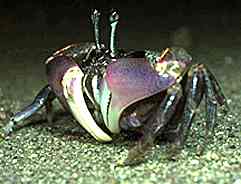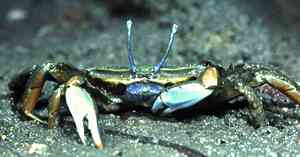|
|
Deposit Feeders
For marine animals there is another source of food which is available to them that is unavailable to land animals. This is the thin layer of ooze which coats the surface of rocks, sand and mud after the tide has gone out.
This ooze, called detritus, consists of bacteria and the remains of finely chopped up algae and decaying fragments of animals, as well as countless numbers of stranded microscopic, one-celled green plants which are called diatoms. This is a rich, thin, soup. Animals which eat detritus are called detritivores.
 Detritus
is a very rich food and there are many types of marine and intertidal
animal groups which are fully adapted to feeding upon it. These animals
have special adaptations for dealing with the food contained within the
muck.
Detritus
is a very rich food and there are many types of marine and intertidal
animal groups which are fully adapted to feeding upon it. These animals
have special adaptations for dealing with the food contained within the
muck.
This the detritus-coated clumps of muddy-sand so that its feeding mandibles can nibble off the nutrient rich detritus food.
Some Nassarius molluscs bulldoze through the sediments. Others like this Semaphore Crab, Heloecius cordiformis (above) has feeding claws shaped like spoons to shovel up and manipulate the mud. Using their mouthparts they sift through the slimy muck to gather the food nutrients, discarding the left-over mud or sand, or quickly passing unwanted sediments through their bodies. Many worms and molluscs leave excreta trails behind them.
Some detritus feeders are the nereid worms and the heart urchin which prefer more calm habitats.
Some small gastropod molluscs are also browsers, grazers and detritus-eaters. They move along the moist pool surface, scraping off the surface scum as well as microalgae living there.
 Some
estuarine shore crabs, such as the Semaphore Crab, Heloecius cordiformis,
shown above, and the Mudflat Sentinel Crab,
Macropthalmus setosus, at the left, as well as the tropical beach-living
Sand Bubbler Crab, Scopimera inflata, are detritus feeders. The
Sand Bubbler crab carves out grooves in the sand as it chomps along, quickly
sifting out detritus particles with its highly adapted mouthparts, leaving
distinctive, straight trails of neatly rolled up balls of sand behind.
Some
estuarine shore crabs, such as the Semaphore Crab, Heloecius cordiformis,
shown above, and the Mudflat Sentinel Crab,
Macropthalmus setosus, at the left, as well as the tropical beach-living
Sand Bubbler Crab, Scopimera inflata, are detritus feeders. The
Sand Bubbler crab carves out grooves in the sand as it chomps along, quickly
sifting out detritus particles with its highly adapted mouthparts, leaving
distinctive, straight trails of neatly rolled up balls of sand behind.
References:
Davey, R.K. (1998). A Photographic Guide to Seashore Life of Australia. New Holland Press.
Pope, E.C. & McDonald, P.M. (1981). Exploring between tidemarks. Australian Museum, p. 24, Sydney.
Shepherd, S.A. & Thomas, I.M. ( 1982). Marine Invertebrates of Southern Australia. Pt. 1: p.30. South Australian Government Printer.
Nutrient
Absorbers
Grazers & Browsers
Suspension Feeders
Deposit Feeders
Carnivores
Omnivores
Trophic Levels
Energy Pyramid
Home
Page
Taxonomy
Biogeography
Rocky Shores
Tidal Levels
Intertidal Zonation
Environmental Factors
Biological
Factors
Feeding Relationships
Activities
Glossary
References
 Life
on Australian Seashores
Life
on Australian Seashores
by Keith Davey (C) 2000
Learning Consultant
- Media
The University of Newcastle
email at australian_seashores@hotmail.com
Scientific Consultant: Phil
Colman
site created 01.01.98 : updated 01.04.2000
